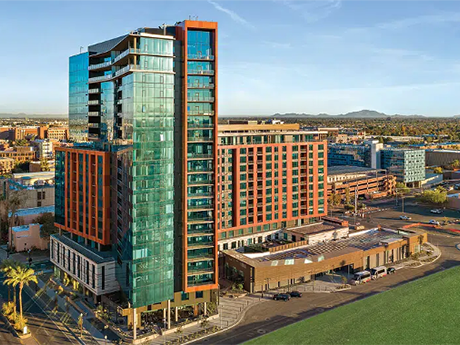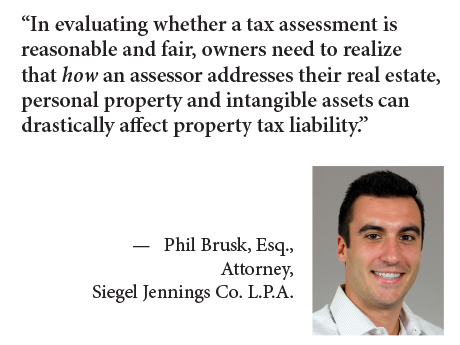PHILADELPHIA — Andrew Carle believes that university retirement communities (URCs) represent a potential game-changing opportunity not only for the seniors housing industry but also for universities and retirees, if executed properly. Yet, URCs are also extraordinarily complicated to operate, cautions the founder of UniversityRetirementCommunities.com, the first directory and information resource of its kind, which lists more than 85 such communities nationwide. “It doesn’t get more difficult than trying to merge big, large, bureaucratic state universities that move very slowly and who live in a bubble of 20-year-olds with the senior living industry that’s very fast-paced, investor-oriented and focused on 80-year-olds. If you had to think of an odd couple, that would be it,” said Carle, an adjunct faculty member at Georgetown University and president of Carle Consulting. His comments came at the InterFace Seniors Housing Northeast conference on Dec. 5. at the Live! Casino & Hotel Philadelphia, where he was the keynote speaker. Up until the last 15 years, there were only a handful of URCs nationwide, but today it’s among the fastest growing segments in the senior living industry, said Carle. While the vast majority of URCs are loosely connected to institutions of higher learning, the top dozen or so …
Northeast Feature Archive
Stars Are Aligned for Healthy Seniors Housing Investment Climate in 2025, Says InterFace Panel
by John Nelson
The investment market for seniors housing is in a favorable position heading into the new year thanks to a confluence of factors, says Scott Corbin, director at Boston-based AEW Capital Management. The firm has roughly $3 billion in assets under management within this niche property type. “We’ve seen a full rebound in recovery. We’re not necessarily back to pre-pandemic [profit] margins, but we are getting close. We are seeing outsized NOI growth and outsized rent growth when you compare it to other asset classes. We have the demographic tailwinds. In addition, you have muted supply [growth],” explained Corbin, a panelist at the InterFace Seniors Housing Northeast conference, which took place Dec. 4-5 in Philadelphia. Editor’s note: InterFace Conference Group, a division of France Media Inc., produces networking and educational conferences for commercial real estate executives. To sign up for email announcements about specific events, visit www.interfaceconferencegroup.com/subscribe. Joining Corbin on stage at Live! Casino & Hotel Philadelphia were moderator Kory Buzin, director, Blueprint Healthcare Real Estate Advisors; and panelists Curtis King, executive vice president, HJ Sims; Dennis Murphy, chief investment officer, Priority Life Care; Rick Swartz, senior managing director, JLL; and Shani Walter, managing director, Omega Healthcare Investors. The daylong conference, …
FeaturesHeartland Feature ArchiveMultifamily & Affordable Housing Feature ArchiveNortheast Feature ArchiveSoutheast Feature ArchiveTexas & Oklahoma Feature ArchiveWestern Feature Archive
Forecast Survey: What’s Your Take on Commercial Real Estate in 2025?
by John Nelson
The editors of REBusinessOnline.com are conducting a brief online survey to gauge market conditions in 2025, and we welcome your participation. The survey should only take a few minutes to complete. Questions range from property sectors that you are most bullish on heading into 2025 to trends in deal volume to your outlook for interest rates. The results of our 14th annual survey will be compiled and published in the January issues of our regional magazines. Conducting these surveys is part of our mission at France Media to provide readers with indispensable information, and we couldn’t do it without your help. To participate in our broker/agent survey, click here. To participate in our developer/owner/manager survey, click here. To participate in our lender/financial intermediary survey, click here. (Note: Please remember to click on “done” to properly submit the survey.)
FeaturesHeartland Feature ArchiveIllinoisMidwestNortheastNortheast Feature ArchiveOhioPennsylvaniaSeniors Housing
Dual Appraisal Methods Improve Opportunities to Get Fair Taxation for Seniors Housing Properties
by John Nelson
By Phil Brusk and Caleb Vahcic of Siegel Jennings Co. L.P.A. The seniors housing sector can’t seem to catch a break. Owners grappling with staffing shortages and other operational hardships lingering from the pandemic are facing new challenges related to debt and spiraling costs. High interest rates and loan maturations loom over the industry, with $19 billion in loans coming due within the next 24 months, according to Cushman & Wakefield’s “H1 2024 Market Trends and Investor Survey” on senior living and care. Factors driving high costs include wage pressures, inflation and — incredibly — rising property taxes. Despite operational challenges and declining occupancy at many facilities during the COVID-19 pandemic, property tax relief for seniors housing was mixed. Many assessors resisted downward adjustments to taxable values, maintaining that recovery was around the corner. Now, seniors housing operators face property tax assessments that equal or exceed pre-pandemic levels. As in the hospitality sector, most seniors housing owners understand that their operating properties include more value components than real property alone. In evaluating whether a tax assessment is reasonable and fair, however, owners need to realize that how an assessor addresses their real estate, personal property and intangible assets can drastically …
By Jason Penighetti, Esq., of Forchelli Deegan Terrana Valuing contaminated properties presents numerous challenges due to the complexity and uncertainty that contamination entails. The presence of hazardous substances or pollutants can affect both a property’s value and potential uses. As an assessment must reflect market value, contamination can significantly impact taxable valuation. Determining the extent of that impact requires careful consideration of legal, technical and economic factors as the valuation of contaminated properties is governed by a combination of statutory law, regulatory guidance and case precedents. Yet these are the fields that taxpayers with contaminated real estate must tread to evaluate assessments for fairness and, if necessary, to appeal an unfair assessment. Tax assessment review proceedings are crucial mechanisms for all property owners to ensure fair and accurate assessments. These proceedings provide avenues to challenge property assessments that owners believe are incorrect or unfair. Understanding the process, timelines and legal considerations involved is essential for property owners, assessors and legal professionals alike. Most real estate taxes in the United States are ad valorem or “according to value.” Thus, the owner of a high-value property would expect to pay more real estate taxes than the owner of a lower-value asset. While …
Cushman & Wakefield: Manhattan’s Fifth Avenue Remains Most Expensive Street in the World for Retailers
by John Nelson
NEW YORK CITY — Fifth Avenue in Manhattan has retained its No. 1 ranking as the world’s most expensive retail destination at approximately $2,000 per square foot, which is unchanged from last year. That’s according to the 33rd edition of the Cushman & Wakefield (NYSE: CWK) Main Streets Across the World, an annual report that examines retail rental rates around the world in “high street” locations, referring to bustling, high-end retail districts. Fifth Avenue is world-renowned for its luxury offerings, including Bergdorf Goodman, Prada, Saks and Tiffany, among others. Additions to Fifth Avenue’s retail store count this year include a new store for Harry Winston and newcomers to the corridor Asics, Dyson, Skechers, Johnston & Murphy and Bandier, according to online directory Visit 5th Avenue. While on par with the rents charged last year, Fifth Avenue’s average retail rate is up 14 percent from pre-pandemic levels, making it only one of three high streets in the top 10 that have increased rates since that time span. The No. 2 retail destination in Main Streets Across the World is Milan’s Via Montenapoleone at $1,766 per square foot. The district jumped a spot into second from last year’s report by pushing rental …
FeaturesHeartland Feature ArchiveMultifamily & Affordable Housing Feature ArchiveNortheast Feature ArchiveSoutheast Feature ArchiveTexas & Oklahoma Feature ArchiveWestern Feature Archive
Forecast Survey: What’s Your Take on Commercial Real Estate in 2024?
by John Nelson
The editors of REBusinessOnline.com are conducting a brief online survey to gauge market conditions in 2024, and we welcome your participation. The survey should only take a few minutes to complete. Questions range from property sectors that you are most bullish on heading into 2024 to trends in deal volume to your outlook for interest rates. The results of our 13th annual survey will be compiled and published in the January issues of our regional magazines. Conducting these surveys is part of our mission at France Media to provide readers with indispensable information, and we couldn’t do it without your help. To participate in our broker/agent survey, click here. To participate in our developer/owner/manager survey, click here. To participate in our lender/financial intermediary survey, click here. (Note: Please remember to click on “done” to properly submit the survey.)
By Rod Olivero, senior director at Getzler Henrich It appears that the hybrid workforce is here to stay, leaving the future of traditional office space largely unknown. As return-to-office policies continue to evolve, an increasing number of companies are either embracing, or adjusting to, the reality that accommodating some level of remote workforce is now an inevitability. When workers packed up their laptops and work documents and walked out of their offices in March 2020 in compliance with U.S. stay at home mandates, few employer/tenants, landlords or lenders could have imagined what would ensue. The state of the workforce today isn’t merely a function of employees not wanting to return to an office environment on either a full- or part-time basis. In more cases than one might imagine, companies are coming to realize that they can, in fact, operate effectively and with great efficiency under some level of remote worker scenario. Collectively, these businesses occupy tens of millions of square feet of office space in some of the nation’s most historically valuable urban real estate markets. Regardless of their motivation, as more companies embrace or acquiesce to the reality of remote work, companies have started to shrink their physical footprint …
FeaturesHeartland Feature ArchiveNortheast Feature ArchiveOtherSoutheast Feature ArchiveTexas & Oklahoma Feature ArchiveWestern Feature Archive
Forecast Survey: What’s Your Take on Commercial Real Estate in 2023?
by John Nelson
The editors of REBusinessOnline.com are conducting a brief online survey to gauge market conditions in 2023, and we welcome your participation. The survey should only take a few minutes to complete. Questions range from property sectors that you are most bullish on heading into 2023 to trends in deal volume to your outlook for interest rates. The results of our 12th annual survey will be collated and published in the January issues of our regional magazines. Conducting these surveys is part of our mission at France Media to provide readers with indispensable information, and we couldn’t do it without your help. To participate in our broker/agent survey, click here. To participate in our developer/owner/manager survey, click here. To participate in our lender/financial intermediary survey, click here. (Note: Please remember to click on “done” to properly submit the survey.)
Company NewsFeaturesHeartland Feature ArchiveHospitalityIndustrialMixed-UseMultifamilyNortheast Feature ArchiveOfficeRetailSoutheast Feature ArchiveTexas & Oklahoma Feature ArchiveWestern Feature Archive
Forecast Survey: What’s Your Take on Commercial Real Estate in 2022?
by John Nelson
The editors of REBusinessOnline.com are conducting a brief online survey to gauge market conditions in 2022, and we welcome your participation. The survey should only take a few minutes to complete. Questions range from property sectors that you are most bullish on heading into 2022 to trends in deal volume to your outlook for interest rates. The results of our 11th annual survey will be collated and published in the January issues of our regional magazines. Conducting these surveys is part of our mission at France Media to provide readers with indispensable information, and we couldn’t do it without your help. To participate in our broker/agent survey, click here. To participate in our developer/owner/manager survey, click here. To participate in our lender/financial intermediary survey, click here. (Note: Please remember to click on “done” to properly submit the survey.)
Newer Posts











